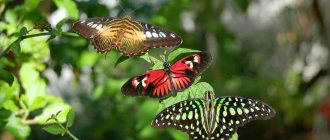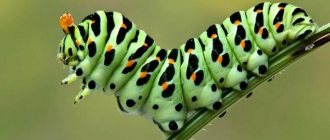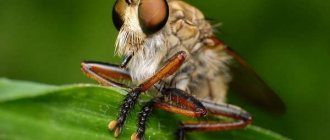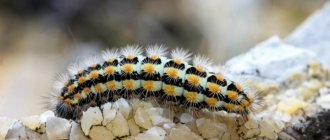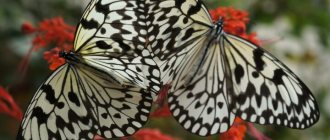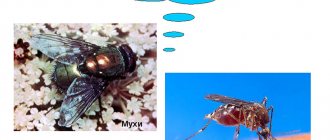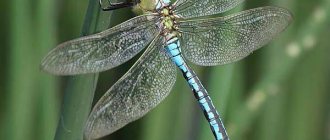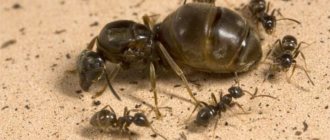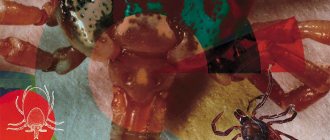Description and structure of the butterfly
If we consider the structure of a butterfly, we can distinguish two main parts: the body and the wings. In turn, the body consists of:
- heads (rounded shape, large eyes, antennae, mouthparts, most often in the form of a proboscis, may be underdeveloped);
- chest (most often consists of 3 segments) with 3 pairs of legs located on it;
- The abdomen (in the shape of an elongated cylinder) consists of 10 segments, with spiracles located on the sides.
Structure
Butterflies have 2 pairs of wings, which are covered with flat scales, which is why the order received the name Lepidoptera. The appearance of butterflies of different species is strikingly different from each other. This is due to the existence of many sizes and colors. The scales on the wings can be of very different shapes and colors. And the size of the wings themselves, depending on the species, varies from 2 mm to 30 cm.
Where do they live in nature?
There is a huge variety of butterflies that inhabit almost the entire planet, with the possible exception of the icy expanses of Antarctica and the highlands covered with snow all year round. The most numerous group of butterflies inhabits regions with a tropical climate, but quite a large number are also found in temperate latitudes.
According to scientists, the largest number of butterflies is in Peru and India (Sikkim state). Some species are distributed almost throughout the world, while others have a very narrow habitat. Lepidoptera can live not only on the plains, but also in the mountains at an altitude of several thousand kilometers above sea level.
What do butterflies eat?
Even a child can answer the question of what a butterfly eats. This is nectar and pollen of flowering plants, but besides this, in the diet of beautiful creatures:
- plant juices;
- sweet fruits;
- honey;
- tear fluid and blood of some animals;
- sweat and excrement of large animals.
In many species, adults do not eat at all, maintaining their livelihoods using nutrients accumulated during the caterpillar stage.
Reproduction
Reproduction of butterflies is often accompanied by various, sometimes very complex, forms of courtship. This could be mating dances or flights. Some butterflies secrete special pheromones that attract a partner of the opposite sex. Moreover, depending on the species, both females and males can release pheromones.
During mating, the female receives from the male not only sperm, but also proteins and trace elements necessary for the formation of eggs. The mating process can last from 15–20 minutes to several hours.
Organs of vision
The butterfly has two compound eyes on its head. Each eye consists of many individual ocelli. For example, one eye of the death's head hawk moth consists of 25 thousand ocelli.
Each eye sees a tiny section of an object, space, and the butterfly’s brain puts together a whole image from many individual pictures, like a “mosaic.”
Moths have very sharp eyes.
All butterflies see objects only at a close distance, but they distinguish colors perfectly, detect the movement of objects and changes in their illumination.
Moths very often die when they fly into the light of a lit lamp, lantern, or candle. This is due to the fact that at night they navigate by the light of the stars, like a compass. Butterflies constantly fly at right angles to the rays of light. And if a lit lamp is close, then the light that comes from it leads the butterflies astray. They begin to circle around the lamp until they bump into it.
Life cycle
Lepidoptera are insects with a full cycle of transformation. The life cycle of a butterfly consists of 4 stages:
- egg;
- larva (caterpillar);
- chrysalis;
- adult insect (imago).
The duration of each cycle depends not only on the species of the insect, but also on climatic and weather conditions.
Egg
After mating, female butterflies lay eggs. Most lay eggs on the leaves or shoots of the food plant, but some lay eggs in the soil or on its surface.
Oviposition
The shape and shade of eggs can be very different. Oval, round, conical, cylindrical eggs are painted in white, sand, light green, pink, blue, brown. The embryo located in the egg is protected by a dense shell, and its development occurs due to nutrients.
The egg stage lasts from 7 – 15 days to several months (if the egg overwinters). Depending on the species, butterflies lay different numbers of eggs from several dozen to a thousand.
Caterpillar
At this stage, insects look like worms. They have a well-developed gnawing mouthpart, so immediately after hatching they begin to actively feed. Thanks to this, the development and growth of the butterfly larva occurs quite quickly. In addition, caterpillars store building substances necessary for subsequent transformation into a butterfly.
Caterpillars experience 4-5 molts, after each of which they increase in size. The larvae of some species molt up to 40 times. The development of a butterfly larva lasts from several weeks to several years.
What do caterpillars eat?
For the most part, the larvae eat plant food (leaves and young shoots, tree bark, inflorescences and fruits of plants), unlike adult lepidoptera, which feed on the nectar of flowers. But the diet of some caterpillars consists of foods such as:
- wood;
- lichens;
- mushrooms;
- skin, wool, hair, horny substances;
- wax;
- weakened and sick relatives;
- caterpillars of other species;
- scale insects;
- snails
During development, the caterpillar increases in size tens of times.
How long does the caterpillar stage last?
The duration of the caterpillar stage depends on the type of insect and the conditions in which it lives. From the moment the larva emerges from the egg until the start of pupation, it can take several days or several years.
Doll
Caterpillars have special glands that produce a strong, silky thread. When the larval phase is completed, the insect begins to secrete a thread and wrap itself in it, forming a cocoon. It is inside the cocoon that the amazing transformation of a caterpillar into a butterfly takes place.
The pupae are absolutely motionless and most often have a nondescript coloring, which saves them from attacks by birds and insect predators. The pupal stage lasts from 2-3 weeks to several months.
Imago
When the adult butterfly has finally formed, it secretes a caustic substance that corrodes the shell of the cocoon. Through the resulting hole, the insect climbs out. After this, the butterfly needs a few more hours for its wings to dry and become dense, after which the beauty takes off on its first flight in its life.
Birth of a butterfly
The lifespan of the imago varies from several hours to several months, but most often the butterfly lives for a couple of weeks.
Urticaria - the harbinger of spring
Starting from the example of the well-known hives, we will find out what butterflies are, how many legs they have, and how their amazing transformations occur.
One of the most unique and at the same time frequently encountered representatives of the Nymphalidae family is the urticaria butterfly (Aglais urticae). It can be seen throughout North America, Europe, Russia, Asia, China and Japan. And it is named so in honor of its caterpillar’s addiction to one type of food - nettles.
Male urticaria die in the fall, and fertilized females overwinter in cracks, sheds, basements, attics and other secluded places, wrapping their body with wings like a blanket, and sometimes even freezing through and turning into a shard of ice.
These are one of the few butterflies that overwinter as an imago (adult). But already in April, with the first rays of the sun, urticaria emerge from hibernation and delight our eyes with bright black and orange spots against the background of the first greenery.
Butterflies in winter
Depending on the species and habitat, Lepidoptera overwinter in different ways. It’s worth starting with the fact that many species of butterflies simply do not survive until the cold weather, dying in the summer or autumn. Others can survive the cold season, and again, depending on the species, they overwinter both in the egg stage and in the stage of larvae, pupa or adult butterfly.
Larvae or pupae can survive the winter in secluded places - under the bark of a tree, in the top layer of soil, in a pile of fallen leaves. Temperature-insensitive pupae overwinter without shelter, for example, attached to a branch.
Anabiosis of Lepidoptera
Representatives of certain species overwinter as adults. In this case, the butterflies find somewhere to hide, climb into the selected crevice, crack or hollow, wrap their wings around their body and fall into sleep. Some butterflies, in search of a suitable place, fly into houses where they spend the winter. After butterflies hibernate, they spend the entire winter in this state and only come to their senses when it gets warmer.
But still, there are not many species that sleep in winter as adults. Mostly pupae spend the winter.
Migratory butterflies
With the exception of tropical inhabitants, all other butterflies disappear with the onset of autumn. But if some of them die, and others hide for the winter, then there are still others. They go to areas with a warmer climate. Some fly close, while others can travel thousands of kilometers.
Migratory
The migration process of Lepidoptera has not yet been studied. In particular, scientists cannot understand how insects, which have a fairly primitive nervous system, can find their way to get to the right place and then return back.
Total number
The order Lepidoptera undoubtedly stands out among taxa of a similar rank in terms of species diversity. Lepidoptera are one of the largest groups of insects, including, as of August 2013, 158,570 species, including 147 fossil taxa. It is estimated that up to 100,000 species remain still unknown to science and, thus, the total number of lepidopteran species existing on the planet can be estimated at approximately 200,000 - 225,000 species. There are 2,166 genera and 8,879 species found in Russia.
Lepidoptera are very diverse, and most of their species are poorly studied. Some of the described species are known from finds from a single locality or even from a single specimen. A true estimate of the total number of species in existence will never be known because many species became extinct before they were discovered. The taxonomy of butterflies presented in various works reflects the different views of their authors and is, without a doubt, debatable.
There are disputes regarding the systematic position or the need to maintain the status of certain subspecies or species. DNA studies suggest that some of the currently known species must be separated. A well-known example is where the seemingly identical Colias alfacariensis and Colias hyale , previously thought to be one species, were split into two after significant differences in the structure of their caterpillars and pupae were discovered.
The benefits and harms of butterflies
The benefit or harm that butterflies bring largely depends on what stage of development the insects are at. Thus, the vast majority of caterpillars are pests that destroy both agricultural and wild plants. But adult butterflies participate in the pollination of many plants.
For reference! Many scientists are of the opinion that the role of butterflies in the pollination process is greatly exaggerated. When they drink nectar, they prefer not to get their paws dirty with pollen, which means they don’t transfer it to other plants.
Larvae and adult butterflies are food for birds and insectivorous animals. Some varieties of caterpillars feed on insect pests. Speaking about the benefits of butterflies, one cannot fail to mention the silkworm, which is used in the production of natural silk.
Well, of course, one cannot downplay the aesthetic significance of butterflies in human life. They help to understand and enjoy the beauty of nature.
Nutritional Features
Basically, insects prefer to eat pollen, flower nectar, tree sap, overripe fruits, but there are also special species that are picky eaters. For example, the hawk moth, a honey lover, enters the hive and enjoys its favorite food. Some members of the nymphalid family replenish moisture loss by eating the urine and sweat of wild and domestic animals. Some tropical butterflies prefer crocodile tears as moisture.
Insects, which do not have a mouthpart at all and live extremely short lives, use supplies that were made when the caterpillar found it. Some types of butterflies are real vampires. They replenish lost strength by consuming animal blood.
Interesting Facts
The origin of the word “butterfly” in Orthodox countries comes from the words “old woman” or “grandmother”, because Since ancient times, people have represented these insects as the souls of dead people. This belief still exists to this day in villages and villages in the Russian outback.
The largest butterfly is the South American tropical moth or tisania Agrippina, its wingspan is 28 cm; in Russia, the Maaka swallowtail (up to 13.5 cm). The smallest is the baby moth, living on the Canary Islands; its size barely reaches 2-4 mm.
A butterfly, flying from flower to flower, can cover up to 10 km in 1 hour, thus moving to the place where it will lay eggs.
One of the most amazing butterflies, Greta, amazes with its transparent wings, through which the entire surrounding world is visible.
What do the legs of a hives look like?
The legs of the wren, like those of other butterflies, are called running legs. They are classified as such due to their structural features. They, like other species of butterflies, are segmented and are divided into five segments, which are called the coxa, trochanter, femur, tibia and tarsus. The paws are divided into five more segments and have a pair of claws at the end.
Almost all butterflies have spurs on the front legs (the so-called pineal gland), which the insect uses to clean the antennae. True, for example, it is difficult to answer how many legs the bagworm butterfly has, since its legs are reduced almost completely.
